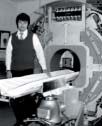 History of PET and MRI
History of PET and MRI
Modern medical imaging began with discoveries during the nuclear medicine program of the 1940s to 1990s and was funded by DOE's Office of Biological and Environment Research (BER). Nuclear Magnetic Resonance (NMR) spectroscopy is one of the advancements developed in this program. By imaging the behavior of atomic nuclei in a magnetic field, NMR enables scientists to study the structure and properties of molecules.
Most MRI and PET machines in the United States are installed at larger hospitals, national laboratories, and university medical centers.
Expanded Timeline (1929–1998)
Magnetic Resonance Imaging (MRI)
Magnetic resonance imaging (MRI) technology was a direct result of NMR advancements to study living tissues. The medical use of NMR is referred to as MRI.
MRI was developed from research conducted independently by Raymond Damadian, a physician at State University of New York (SUNY) Brooklyn; and Paul Lauterbur, a chemistry professor at SUNY Stony Brook. The first commercial MRI scanner was produced in March 1980.
Positron Emission Tomography
Positron emission tomography (PET) builds images by detecting energy given off by decaying radioactive isotopes.
Isotopes are atoms of an element with the same number of protons (positively charged particles) in the nucleus but a different number of neutrons (neutral particles). Because radioactive isotopes are unstable, as they decay they throw off positrons that collide with electrons and produce gamma rays that shoot off in nearly opposite directions.
PET systems use the paths of the two detected gamma rays to determine the originating collision point, a process called electronic collimation. The scanners use a circular series of gamma ray detectors to envelop the patient or test animal to detect both gammas so the instrument can use electronic collimation to predict where the energy signal originated. This signal is then converted into a three-dimensional image slice.
The first PET camera was built for human studies by Edward Hoffman, Michael M. Ter-Pogossian, and Michael E. Phelps in 1973 at Washington University, with DOE and NIH support. Phelps, who is often credited with inventing PET, received the 1998 Enrico Fermi Presidential Award for his work. The first whole-body PET scanner appeared in 1977. Today, there are over 400 PET scanners in use worldwide.
